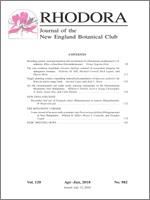Long-term monitoring of the rare southern twayblade (Neottia bifolia; Orchidaceae) and understorey of a black spruce-tamarack, swamp community was conducted after construction of an airport taxiway above the swamp edge. Succession documented over 14 years in the treed swamp edge following disturbance involved loss of the twayblade, invasion by guilds of annuals, and shifts between original and new guilds of wetland plants. Despite changes, the twayblade was the only plant extirpated from the swamp edge community although fungal richness (mainly basidiomycete) was substantially lower in the edge than the swamp interior. NMS ordination indicated that the orchid niche is an undisturbed swamp with an intact tree canopy and unbroken mat of Sphagnum which supports a diverse mycorrhizal community adapted to summer water table drawdown and low ionic groundwater chemistry (e.g. Cl<10 mg/L). Fourteen years after the disturbance, southern twayblade populations in the swamp interior, 100 m from the edge were in steady decline. The woodland orchids may be sentinels of ecosystem integrity. Loss of the twayblade signalled the onset of a post-development, disturbance-cascade: installation of an impervious surface restricted infiltration, altered run-off quantity and quality which subsequently resulted in loss of the ecosystem engineer, Sphagnum, and keystone mycorrhizal fungi.
How to translate text using browser tools
18 June 2018
The Rare Southern Twayblade (Neottia bifolia): Sentinel of Ecosystem Integrity For Sphagnous Swamps
Nicholas M. Hill
ACCESS THE FULL ARTICLE

Rhodora
Vol. 120 • No. 982
Apr-Jun 2018
Vol. 120 • No. 982
Apr-Jun 2018
black spruce swamp
mycotrophic
Neottia bifolia
post-development disturbance cascade
rare plants
sentinel ecosystem integrity




